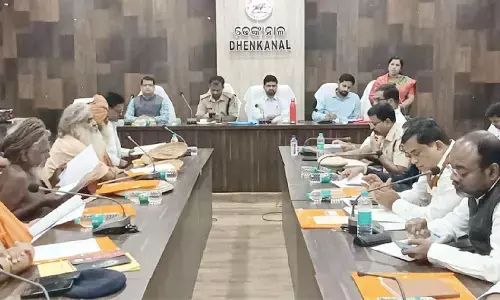A medieval port town with almost 2,000 years of history
The Motupalli village in Prakasam district has proved to be having historical and archaeological support as it has been existing from as early as 2nd century AD and developed from a pirates den to a cosmopolitan city over hundreds of years.
The Motupalli village in Prakasam district has proved to be having historical and archaeological support as it has been existing from as early as 2nd century AD and developed from a pirates den to a cosmopolitan city over hundreds of years. The inscriptions by the kings and emperors installed in Motupalli explain how the medieval rulers gave importance to sea trade, that too from the major port town in the kingdom, Motupalli.
Until the late 20th century, the historians assessed that Motupalli served as a port in the medieval times, of the 11th and 12th centuries, from the unearthed coins of Rajaraja from the Chola dynasty, Chinese coins of the Ming dynasty, and other ironware and celadon ware. The excavations conducted in the late 20th century at Motupalli provided enough evidence like European rouletted ware and stamped ware that pushed back the antiquity of Motupalli to at least 2nd century BC, and the town had trade relations with Europe, China and South-East Asian Countries from very early days.
Recording his sea tours around the world, the Greek geographer Claudius Ptolemy (100-170 AD), who proposed a geocentric system of planets, mentioned Mousopalli as a metropolis while mentioning inland cities of pirates. The researchers proved later that Mousopalli is the Motupalli, which can be translated into Telugu as the village of rough and rude people. This town of pirates later developed into a centre of international trade and became home for people from various nations speaking numerous languages.
Over the hundreds of years, the kings and emperors of the region encouraged the sea trade with Motupalli as the primary port. As the duties levied on the trade, imports and exports at Motupalli port are making them rich, the rulers stationed armed men at the port to provide security to the locals, merchants and traders from the pirates. The flourishing town and the kingdom it is in, also attracted invasions from other kings and destabilized the business at Motupalli by 1100 AD.
But, the later emperors like Kakatiyas of Warangal, Reddis of Kondaveedu, Sangamas of Vijayanagara dynasties encouraged the merchants from other kingdoms, other lands to stay, trade and flourish by protecting them from oppressive taxation and providing safety at Desyuyakkonda Pattanam, also known as Motupalli.
By the time the Venetian traveller Marco Polo landed in India, during the Rudramadevi reign around 1280 AD, he found diamonds, delicate cotton, fine silk clothes, muslin just like tissues of spider webs along with others being exported from Mutfili, aka Motupalli. By this time, the seaborne traders were enjoying the security and meagre duties on the cargo as mentioned in the Abhaya Sasana by Kakatiya Ganapatideva. The Abhaya Sasana, which is carved on a pillar of the mandapa in front of Veerabhadra Swamy temple in 1244-45 AD, in Telugu and Sanskrit languages and is still available.
Earlier, the whole cargo including the gold, elephants, horses, gems being carried by vessels of foreign traders by sea but were attacked by storms, wrecked and thrown onto the coast were taken away by the kings by force. Abhorring the practice, Maharaja Ganapatideva installed the edict of safety out of mercy and for his glory and merit at the chief port of Kakatiya kingdom, promising the merchants that they can take the cargo by just paying the usual duties in practice.
Following the order of his father Ghiyasuddin Tughluq, the prince Fakhr Malik Jauna Khan famously known as Muhammad bin Tughluq defeated Prataparudradeva in his second attempt in 1323 AD. The Reddi kings of Kondaveedu recaptured the Motupalli nearly after two decades by defeating the local enemy chiefs. The king Annapota Reddi incised a charter of concessions to merchants coming to settle and trade at Motupalli in Telugu and Tamil on another pillar of mandapa in front of Veerabhadra Swamy temple, and fixed duties on articles of export and import in 1358 AD.
To attract the merchants who deserted Motupalli, Annapota Reddi abolished taxes like aputrika dandam, kaddayam etc, on foreign merchants and remitted duty on gold and silver along with reducing 1/3 of the duty on sandal. He fixed rates to of duty as 3 packages for every 100 packages coming from the south, 5 packages for every 100 packages coming from north, 3 coins on 100 clothes export to south, 2 coins on 100 clothes export to the north, and 3 coins on 100 clothes and 7 ½ coins on pearls exporting to foreign lands while the remaining are continue to be same.
By that time, the sea trade boomed with Motupalli as the centre, the local merchants flourished with abundant wealth. Also, traders from various places got settled in the town establishing businesses of the products from their homeland. One of the prominent merchants is Avachi Tippaya Setty, who is also known as Tripurantaka Setty and Tripura Setty. Tippayya Setty's elders came from Kanchipuram and settled in Motupalli and are experts in the seaborne trade. The celebrated poet Srinatha, who is a poet in the court of Kumaragiri Reddi, dedicated his Haravilasamu to Tippayya Setty, who himself carried on the maritime trade with islands and countries like China, Srilanka, Sumatra, Malaysia, Persia, Goa, Bhutan, Taiwan, Laos and others importing and exporting silk clothes, horses, elephants, gems, camphor, gold, liquid civet, pearls, musk, sandal, aloe wood, rose water and saffron.
Just after three decades, the Motupalli port town went into the authority of the Devarayas of Vijayanagara. Being a new ruler to the land, Harihararaya Kumaradevaraya, popularly known as Devaraya II also encouraged foreign traders to continue their patronage in Motupalli and revised the charter of Annapota Reddy in 1390 AD.
Motupalli is in existence for nearly 2000 years and served as a major port town in the Andhra region for 1500 years and encouraged the trade by foreigners. The remains of the great history at the village are now crying for the attention and protection of the government.









